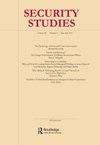12岁时无法得分:技术上正确,但没有击中目标
IF 3
2区 社会学
Q1 INTERNATIONAL RELATIONS
引用次数: 1
摘要
在《无人机总是能通过吗?进攻神话和防御现实》一文中,安东尼奥·卡尔卡拉和合著者在文章开头写道:“新兴和颠覆性技术会产生进攻优势吗?”1为了回答这个雄心勃勃的问题,他们着眼于无人驾驶或自主技术的一个高度领域:中高度长航时和高空长航时武装遥控飞机。2然后,作者用文章的正文详细说明了为什么这些平台无法通过避免探测或饱和防空系统来对抗现代综合防空系统,因此,得出的结论是,新兴技术不一定会带来进攻性优势。3尽管这篇文章的技术分析是合理正确的,但在对一个相当狭窄的自主系统类别的动力和目的进行稻草人式的争论时,其结论最终没有切中要害。对于所有的技术细节,作者都忽略了自主性对未来空袭的潜在影响,这是一种美国飞行员在训练中称之为“12岁时不可储存”的现象——当炸弹在正确的参数范围内投下,但未能降落在影响区附近时使用的术语。4本文章由计算机程序翻译,如有差异,请以英文原文为准。
Unscorable at 12: Technically Correct, but Misses the Mark
In “Will the Drone Always Get Through? Offensive Myths and Defensive Realities,” Antonio Calcara and coauthors open the article with: “Do emerging and disruptive technologies yield an offensive advantage?”1 To answer this ambitious question, they look at one highly scoped segment of unmanned or autonomous technology: Medium-Altitude Long-Endurance and High-Altitude Long-Endurance armed remotely piloted aircraft.2 The authors then use the article’s body to detail why these platforms cannot survive against modern integrated air defense systems by either avoiding detection or saturating air defenses, concluding that emerging technologies, therefore, do not necessarily lead to an offensive advantage.3 Although the article’s technical analysis is reasonably correct, in creating a straw man argument about the impetus and purpose of a rather narrow category of autonomous systems, its conclusions ultimately miss the mark. For all the technical detail, the authors miss the potential impact of autonomy on future air campaigns, a phenomenon that American pilots in training would call “unscorable at 12”—a term used when a bomb is dropped within correct parameters and yet fails to land near the impact zone.4
求助全文
通过发布文献求助,成功后即可免费获取论文全文。
去求助
来源期刊

Security Studies
INTERNATIONAL RELATIONS-
CiteScore
2.70
自引率
16.70%
发文量
27
期刊介绍:
Security Studies publishes innovative scholarly manuscripts that make a significant contribution – whether theoretical, empirical, or both – to our understanding of international security. Studies that do not emphasize the causes and consequences of war or the sources and conditions of peace fall outside the journal’s domain. Security Studies features articles that develop, test, and debate theories of international security – that is, articles that address an important research question, display innovation in research, contribute in a novel way to a body of knowledge, and (as appropriate) demonstrate theoretical development with state-of-the art use of appropriate methodological tools. While we encourage authors to discuss the policy implications of their work, articles that are primarily policy-oriented do not fit the journal’s mission. The journal publishes articles that challenge the conventional wisdom in the area of international security studies. Security Studies includes a wide range of topics ranging from nuclear proliferation and deterrence, civil-military relations, strategic culture, ethnic conflicts and their resolution, epidemics and national security, democracy and foreign-policy decision making, developments in qualitative and multi-method research, and the future of security studies.
 求助内容:
求助内容: 应助结果提醒方式:
应助结果提醒方式:


